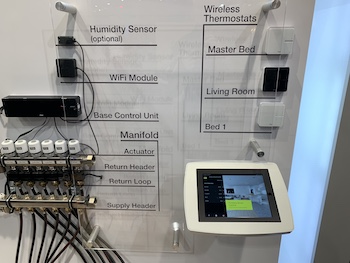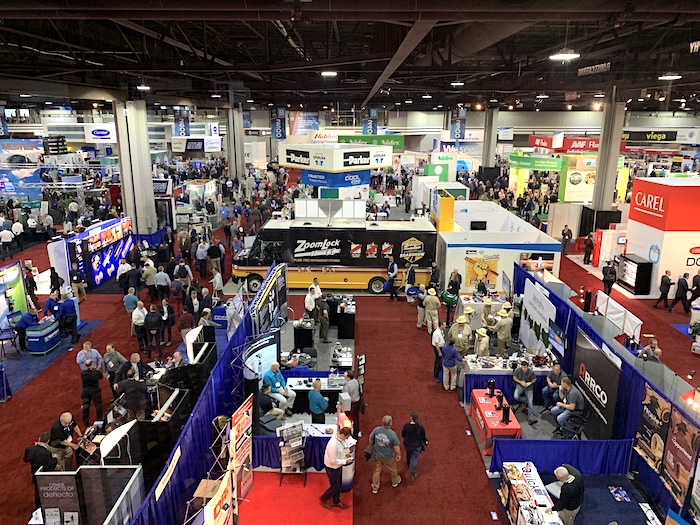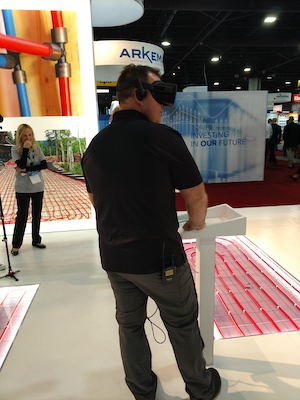We are approaching the end of the 2018-2019 heating season in North America, although homeowners in the colder northern sections of the United States and throughout Canada will likely need their heating systems for another two, maybe even three months. As you know, our long cold seasons can take a heavy toll on hydronic heating Read more
Industry Blogs

We are approaching the end of the 2018-2019 heating season in North America, although homeowners in the colder northern sections of the United States and throughout Canada will likely need their heating systems for another two, maybe even three months. As you know, our long cold seasons can take a heavy toll on hydronic heating systems. Here’s a rundown on some of the more common boiler and component problems facing home and business owners and what can be done to remedy them.
 Radiator cold spots
Radiator cold spots
If your home’s or business’s radiators are not uniformly hot throughout, the following could be the culprit:
- air in the piping and components;
- a malfunctioning component or part, such as a circulator or a valve; and, finally, our “favorite” villain —
- rusty or corroding system pipes that ultimately fill the radiators with magnetite.
What is magnetite? As air and water mix inside the pipes of an untreated hydronic heating system, an iron oxide sludge, called magnetite, forms. As these small (.0003-micron) particles circulate and accumulate inside the system, they begin to adversely affect heat-transfer rates and boiler efficiency. Eventually, iron oxide buildup can lead to equipment damage and/or failure, resulting in costly repairs. Just how extensive is this problem? A recent study analyzing returns to European pump manufacturers found that nearly 70 percent of circulator returns consisted of failures triggered by iron-oxide buildup. The study also showed that more than 95 percent of the debris in hydronic heating systems consists of iron oxide*.
The fix? To eliminate air in the system, first try bleeding your radiators. But if the cold-spot problems persist, bring in a professional plumbing and heating contractor to:
- conduct a full system inspection;
- upgrade failing parts;
- fully cleanse the system with a magnetic dirt filter, as well as a chemical cleaner, such. This maintenance should remove not only the rust, but also all the other debris.
Noisy system
Maybe your boiler rattles every time it rolls into action. Maybe you are routinely treated to a chorus of bangs, gurgles, whistles and rumbles from elsewhere in the system. Regardless, such noise goes beyond mere annoyance; it might indicate more serious problems. Once again, air as well as a buildup of limescale are the most common culprits.
The fix? To eliminate the pipe noise, get rid of any trapped air by bleeding your radiators. If that doesn’t work, call a professional to flush the entire system of limescale and air. If the noise originates in your boiler, your service technician will work to remove limescale in the heat exchanger.
Leaks and drips
Water leakage from your boiler is never a good sign. Leakage usually means a breakdown is imminent. It’s a simple problem to spot. Is there any water beneath the boiler or around its pipes and tank? Causes can range from broken parts to corroded pipes.
The fix? Whether the problem stems from a damaged component or simple wear and tear, there’s only one answer for leaks and drips: Call a professional to check your boiler.
On the subject of leaks, it is often questioned whether cleaning chemicals cause leaks within hydronic systems. The answer to this is — no, if, of course, you are using correctly formulated chemicals, which includes surfactants, dispersants, and inhibitors that make it pH neutral. The surfactants and dispersants help dislodge, lift and move the corrosion, while the inhibitors protect the vulnerable metals during cleaning.
 Complete protection
Complete protection
The rising popularity of high-efficiency boilers and the increased use of high-efficiency ECN (electronically commutated motors) pumps with these boilers, have helped lower fuel bills. That’s the good news. The downside: both of these positive trends can also create system-performance headaches for home and business owners. We will explore the why behind these problems in a future blog. For now, understand that both trends can lead to premature system and component failure because of the buildup of iron oxide sludge (magnetite) and other nonmagnetic debris. Both can rob hydronic heating systems of their high efficiency and superior performance.
The solution is magnetic dirt filtration, along with regular and proper system cleansing and protection. This is the only way to prevent the buildup of magnetite and the costly problems it can cause.
GUEST BLOGGER: Brian Salem, ADEY Western/Central North America area sales manager.
 Growing up in his Dad’s plumbing company, Brian has a wealth of experience within the HVAC/P industry. Professionally, Brian has been in the industry since 2004 and joined ADEY in 2017 – his role began as OEM Manager for North America but due to ADEY’s growing network of North American Reps, Brian has now taken the reigns as ADEY’s Western/Central North America Area Sales Manager. Brian Salem: brian.salem@adey.com, (847) 440-6665
Growing up in his Dad’s plumbing company, Brian has a wealth of experience within the HVAC/P industry. Professionally, Brian has been in the industry since 2004 and joined ADEY in 2017 – his role began as OEM Manager for North America but due to ADEY’s growing network of North American Reps, Brian has now taken the reigns as ADEY’s Western/Central North America Area Sales Manager. Brian Salem: brian.salem@adey.com, (847) 440-6665

A constant cry from across the nation: can’t find good employees. OK, in some cases, an employee of any kind. In Phoenix, my new home town, there is one estimate that if 1000 trained technicians came to town and were ready to work in our industry, we would not fill the gap—at least in our Read more
A constant cry from across the nation: can’t find good employees. OK, in some cases, an employee of any kind. In Phoenix, my new home town, there is one estimate that if 1000 trained technicians came to town and were ready to work in our industry, we would not fill the gap—at least in our summer, which runs from March to Oct. What can an owner do to make sure his customers are served while he grows his business and remains profitable?
Couple of ideas. First, think outside the box. Or outside our industry. In some cases, a tech with a decade of experience walking into your place to apply for a job has some bad habits. They sometimes will say “we didn’t do that at the last place, here is what we did,” even if that thing they did will not fly at your place. Just to digress, I said in some cases. Please understand, a tech with 10 years of experience, who shares your company values, can pass a drug test and has a clean driving record may be the perfect fit for your company. Then hire them.
Back to my thoughts on outside the box. There are some great people in your market, people who may be working at Kinkos, a chiropractor, Starbucks, or any retail establishment. They love people, and just as important, like themselves, have a good self-image. They are not in our industry yet, but they may be a great fit for your company. Stay alert for the person helping you at a shop or restaurant. Do they smile, engage you as they help you? Could be perfect for the office or field.
One common concern is how long will it take to train someone outside our industry, teach them what they need to know. Depends, could be 4 or 5 months, or a year before they are completely productive. My response is always the same. We must think long term. It may be that you are just one man, working out of a truck, have to get some help, they have to have experience. If that is the case, then keep looking for the experience. On the other hand, if you plan on being in business next year, and have more than a couple of techs in the field, make an effort to look for a great person that you can train in the way you want, to do business exactly the way you want it done. Plan on them being in a training role for weeks, maybe months. I
In closing on this subject, if you do not take action today, you may well be in the same position next year, hoping the veteran with a decade of experience who can pass a drug test and has a clean driving record and will work for $10/hour will come thru the door. For an alternative scenario, see below.
Erv Dirks is a client who has a business in rural Wisconsin, town of 3200. Erv was getting work done on a van when the young man asked him what it would take for him to be in the heat and air business. Erv said he would have to start at a training wage, maybe several months to get the feel for the industry. Reader’s Digest version, Erv brought him in, he ran with another tech for weeks, Erv then started him on doing maintenance on installs they had done in the past few years, pretty sure they would be installed correctly and problem free. If he found a problem, he called Erv, got another pair of eyes on the system. That was about a year ago when he brought him in, Erv trained him in how he wanted the work done, exactly what to do, not to do. This summer that young man was doing tune-ups for their existing customers, he turned in 19 leads that Erv sold new equipment on in one 30-day period. Doing an excellent job, last year at this time he was putting brakes on one of Erv’s vans. Now he is making a lot more money, enjoys the work, gets to meet new people several times a day, life is sweet.
Another concept I have seen implemented is a way to use a life insurance policy to help retain the key employees. When you do have an employee who is making a positive difference with customers and their co-workers, keep them. Some of my clients use a whole life policy that builds cash value that can be set up as a carrot to stay with the company. It can be part of a program to keep the productive employees, a great idea.
In Phoenix, Collins Owens is the owner of Collins Comfort Masters, been in business since 1985. Collins hires four college-age young people, brings them into his building from 6am-7:30 am three days a week for training, then the rest of the time they are on the clock as a helper. They get to learn a trade without having to spend $9000 or more from their hard-earned savings.
Collins remarked that there are many HVAC owners in Phoenix who started in his in-house program. He is open about the program, I saw it on his Facebook page. Oh, while in that area, you do have a Facebook page, do you not? Collins has more than 4800 who have liked his page, almost as much who follow his page. He can run a special and get immediate response.
An interesting statistic, more than 70% of people who spent money on household improvements searched on Facebook for testimonials or reviews. You need to be in there, that is the new front porch. Back in the day we sat on front porches, called out as neighbors passed by, talked about what they were doing in their homes. Not so much anymore, now we go to the Internet, look up products and companies and do our research on our iPhone. So, get on their phone.
Jim Hinshaw is Western Division Manager, The EverRest Group, and associate, coach and trainer, Sales Improvement Professionals.

Delayed two hours at O’Hare as I tried to embark to Las Vegas for the 2019 IBS/KBIS Show in Las Vegas, one thing was for certain, I was traveling to warmer temperatures. Or so I thought. I left Chicago in a blizzard and touched down at McCarron Intl. to a spattering of light rain and Read more
 Delayed two hours at O’Hare as I tried to embark to Las Vegas for the 2019 IBS/KBIS Show in Las Vegas, one thing was for certain, I was traveling to warmer temperatures. Or so I thought. I left Chicago in a blizzard and touched down at McCarron Intl. to a spattering of light rain and, WTF, snowfall.
Delayed two hours at O’Hare as I tried to embark to Las Vegas for the 2019 IBS/KBIS Show in Las Vegas, one thing was for certain, I was traveling to warmer temperatures. Or so I thought. I left Chicago in a blizzard and touched down at McCarron Intl. to a spattering of light rain and, WTF, snowfall.
But the chilly temps didn’t put a damper on one of, if not the “hottest” show since the two associations started exhibiting together. This may sound too cliche, but the buzz was palpable. While in the working press room, I overheard one National Association of Home Builders (NAHB) exec say that the show was the best in terms of income, booth number and size, and attendance projections—since the economic downturn.
In fact, the numbers are in, and they concur with the NAHB gentleman: more than 67,000 home building professionals from around the world filled the exhibit halls, and the IBS and the Kitchen & Bath Industry Show (KBIS) once again combined for the annual Design & Construction Week, which drew a total of more than 100,000 attendees.
Inside the Trends
Information from the show conveyed that spending on residential improvements will continue to grow over the next two years at a gradual pace, according to experts at a press conference hosted by the National Association of Home Builders (NAHB) Remodelers during the International Builders’ Show in Las Vegas. Professional remodelers from across the country agreed with the forecast, citing increased consumer confidence and demand.
NAHB predicts that remodeling spending for owner-occupied single-family homes will increase 1.6% in 2019 and another 1.1% in 2020.
“Remodeler confidence continues to remain at a high level, as remodeling spending reached $172 billion in 2018,” said 2018 NAHB Remodelers Chair Joanne Theunissen, CGP, CGR, a remodeler from Mt. Pleasant, Mich. “Although there is steady consumer demand in all areas of the country, the biggest challenges continue to be the costs of labor and materials to meet the interest.”
While multifamily housing starts in 2018 came very close to the sector’s 2015 peak, production levels are expected to moderate somewhat in 2019 and will stabilize in a range that that is considered normal, according to data announced by NAHB.
“Multifamily starts will begin to level off through 2019, edging 2% lower this year at about 379,000 units, approaching the level that was the pre-recession norm,” said Danushka Nanayakkara-Skillington, AVP, Forecasting and Analysis for NAHB. “The great majority of 2018’s units were in buildings with 50 or more apartments.”
The National Kitchen & Bath Association released the results of its extensive “Size of Market Study and Outlook,” revealing a value of $644 billion in sales of products and materials aimed at the residential kitchen and bath market in 2017. This total includes $330 billion from the construction of new homes and $314 billion from residential remodeling and replacement (R&R) projects. Construction of new houses rose 8.6% in 2017, to reach a market size of $330 billion. Remodeling and improvement of existing homes (i.e., residential remodeling) amounted to $314 billion in 2017. This is 6.4% higher than it was in 2016.
NAHB announced other K&B trends, which include farmhouse styles incorporating ample amounts of wood; engineered quartz countertops for color flexibility; vinyl and resilient flooring, especially for aging in place; wireless controls, and open interior and exterior spaces in the kitchen; and higher-end fixture installations in the bathroom, such as wall-mounted sinks, faucets and toilets.
Quick Product Round-Up

Tim Ward talks with Ryan Kim, CEO of Phyn.
The Hub’s Tim Ward talks with Ryan Kim, CEO of Phyn, the joint venture between Uponor North America and Belkin. Here, they discuss one of Phyn Plus’ enhancements—freeze alert. When the temperature drops, the water pressure slowly rises as ice crystals begin to form inside plumbing pipes. Phyn Plus sends alerts related to freeze pressure build-ups anywhere in the home before they lead to pipe bursts. Other leak detectors use a built-in temperature sensor to indicate the water is cold where the device is located, often in a utility closet or basement that may be warmer than an exposed pipe on the other side of the property.
We also did talk with Scott Zins, account manager, Intelligent Water, about the ProSquad, plumbers certified to install the product. Although Phyn Plus can be acquired from the Phyn website, the ProSquad team is still considered vital in the sales of the product. The list of contractors are listed on the website for recommended installation. Also, the warranty is extended if installed by a ProSquad certified installer, and if water damage is incurred after installation, Uponor does offer a deductible payout.

Viega Smart Control
Highly successful in the European market and launching Q4-ish in North America, Viega’s smart control allows homeowners to control temperatures by individual room or zone via thermostats in each room or remotely through a website. It’s programmable and, like “smart thermostats,” it can over time anticipate homeowners’ patterns and preferences and adjust temperatures accordingly. It also can be used to lower energy use when a homeowner is on vacation or absent for a period of time. It has been proven to reduce energy use by 30%.

Rinnai I-Series Boiler
Rinnai North America launched its new I-Series Boiler for the residential market. In 2018 Rinnai launched its M-Series boiler, which offers many benefits to installers such as a compact design, easy installation and ease of service. This year, Rinnai is expanding its presence in the North American boiler market with the new I-Series Boiler launch.
The I-Series Boiler has a unique advantage to homeowners with the ability for simultaneous usage of home heating and domestic hot water production. That means, if the heat is running and someone in the home wants to take a shower, the heat is not interrupted as it is with many traditional boilers in existing homes. The technology also includes an innovative bypass servo valve, which enables precise control of the hot water temperature.
This boiler is available in both combi and heat-only models and comes standard with multi-zone heating control.
Finally, check out this video from the show floor. OLFA is introducing some pretty cool new products. Carl Cottrell was pretty enthusiastic talking about the new offerings.

Dain Hansen is vice president of Government Relations, The IAPMO Group. He lends his frequent perspective of Capitol Hill, and the plumbing industry. Pricey Water Bills Fix Could Mimic Successful Energy Program. Subsidizing water bills for low-income families may be more difficult than a similar successful program for energy, but that’s the road map Read more
 Dain Hansen is vice president of Government Relations, The IAPMO Group. He lends his frequent perspective of Capitol Hill, and the plumbing industry.
Dain Hansen is vice president of Government Relations, The IAPMO Group. He lends his frequent perspective of Capitol Hill, and the plumbing industry.
Pricey Water Bills Fix Could Mimic Successful Energy Program. Subsidizing water bills for low-income families may be more difficult than a similar successful program for energy, but that’s the road map a bipartisan group of lawmakers is exploring. The nature of the water industry—with tens of thousands of municipal-owned water suppliers that often serve 1,000 people or fewer—could make it far more difficult to implement than in the more consolidated power sector, the water industry cautions. Sen. Ben Cardin (D-Md.), one of the lawmakers working on the legislation, said many in Congress are hearing from their constituents that water and sewer bills are beginning to crowd out other items from their household budget. Cardin has said the issue really hit home for him when he was campaigning for a local candidate in Baltimore recently. “Every door I knocked on, they were asking me about their water bills—every door,” he said. “It’s obviously an essential utility and they just can’t afford it.” The bill Cardin is crafting with Sen. Roger Wicker (R-Miss.) and Rep. Marcia Fudge (D-Ohio) is modeled on a program at the Department of Health and Human Services that subsidizes energy bills in low-income areas. It would establish a five-year pilot that would give grants to 32 water utilities across the country to establish low-income assistance programs there. Cardin and Wicker first introduced the bill in the Senate late last year. Cardin said his strategy for this year is to attach the measure to a larger piece of legislation, although it’s possible it could pass on its own, suggests Hansen.
US-China Trade Negotiations. US-Chinese negotiators met in Washington this week as part of an effort to find agreement on their trade disputes by March 1. Limited progress was expected in this week’s talks, and our judgment of the results are in line with those expectations despite the positive talk from the White House following the negotiations. There will be growing anticipation of a final deal later this month, particularly if a potential meeting between President Trump and Chinese Premier Xi takes place, as expected. If a deal is struck by March 1, it will not be a far-reaching agreement that will address the myriad issues that have divided the US and China, particularly structural issues embedded in China’s trading and economic policies. That type of deal will require more time to negotiate – beyond March 1 – and is still not certain even then. It is likely President Trump will seek a more comprehensive agreement – much more than an increase in Chinese purchases of US agriculture and other products. If such an agreement needs a deadline extension beyond March 1, the question is whether there will be increased US tariffs imposed then. This will depend on the pace of progress in the negotiations and the personal Trump-Xi dynamics from their likely meeting. Due to our belief that the Chinese will be slow to make commitments in areas of importance to the US, do not rule out increased tariffs after March 1. While many are confident these negotiations will eventually produce a final deal between the two countries later this year, our sense is that progress will occur slowly and only after more pain is afflicted, poses Hansen.
White House Looks To Move Pipelines Forward. The White House is considering new executive orders that would weaken states’ authority to block energy projects and would help speed the construction of pipelines, according to sources familiar with the matter. Possible actions include changing Obama-era draft guidance for complying with a section of the Clean Water Act as a way to hinder state governors who have used the law to oppose energy projects, according to a person with knowledge of the discussions. The potential executive orders wouldn’t address one of the the oil and gas industry’s main complaints: tariffs on imported steel that executives say hamper growth. Any new executive orders, which could be part of a broader, long-delayed infrastructure plan, would likely draw pushback from Democrats like New York Gov. Andrew Cuomo as well as Republican state leaders who are wary of ceding power to protect their rivers and streams to the federal government. Trump has pledged to drive “U.S. energy dominance” abroad, capitalizing on the decade-long surge in U.S. oil and gas production that has lifted output to record levels. The sector has remained a bright spot in an economy that experts say may be in danger of dipping into recession. U.S. companies have opened the spigots on oil shipments since the ban on exports was lifted in 2015, and the U.S. has become one of the leading global shippers, says Hansen.

The 2019 AHR Show in Atlanta is in the rearview mirror. Before I get into the meat of the show, I wanted to touch upon some of the “infrastructure” surrounding the show. First, most of the activities surrounding the Georgia World Congress Center are fairly concentrated, and that causes traffic problems at peak traffic times Read more
The 2019 AHR Show in Atlanta is in the rearview mirror. Before I get into the meat of the show, I wanted to touch upon some of the “infrastructure” surrounding the show. First, most of the activities surrounding the Georgia World Congress Center are fairly concentrated, and that causes traffic problems at peak traffic times. But I can’t express enough how with a great offering such as Uber and Lyft are, they weren’t a very efficient means of getting around, at least in this city. Most of the GPS coordinates were off, causing long waits or canceled trips. And, to my surprise, many drivers weren’t even familiar with the downtown area, as they were not even from around the area. Not all, but enough for me notice.

I stayed in an AIrBnb for the first time, and although the accommodations were nice, I was told by a driver that I was on the edge of the bad part of town. Not really something you want to hear upon arriving. I really hope everyone’s experience of the city was a good one. Just think, Atlanta sets the stage for one of the biggest events I n the world in a couple of weeks — the Super Bowl!
The AHR Show
The Expo drew more than 65,000 attendees, with 1,809 exhibitors total, 496 international exhibitors from 35 countries and 107 first time exhibitors. I thought the show itself was very good. Well organized, fairly easy to get to and from the two exhibits halls via a connector, once you knew where it was located. It seemed that a lot of the booths had girth, size, and were well presented and represented.

Taco’s John White, Jr. (l) presents the Taco Comfort Solutions 2019 Dan Holohan Lifetime Contribution to Comfort Award to Dan Foley.

Eric Aune tests the VR experience in the REHAU booth at AHR.
The show opened up on Monday, and the Mechanical Hub crew was busy before the opening bell. Eric Aune and his wife Heather were getting the scoop, shooting video on Milwaukee Tool’s new M18 Threader. Look for more information and videos here and on our YouTube channels coming soon. Tim Ward was visiting with our friends at Uponor, learning more about its Copper Press Adapter. Finally, I was visiting with Taco, watching good friend Dan Foley receive the Taco Comfort Solutions 2019 Dan Holohan Lifetime Contribution to Comfort Award. Congrats, Dan!

John Mesenbrink checks out the VR experience in the Bosch Thermotechnology booth.
Some trends worth noticing was the ever-emphasis on energy efficiency, lowering GHG emissions, virtual reality, and interconnected devices, combining Alexa with thermostats, for example, piggybacking off of the CES Show earlier this year, and some products at last year’s Builder’s Show.
Lochinvar had a big announcement, telling the media it has partnered with Danish company, EC Power, to offer a cogeneration system, which pulls waste heat into water storage tank. Using an internal combustion natural gas engine, Micro CHP (< 50 kW/hr), is designed to be an efficient and easy-to-install system intended for light commercial use. Using natural gas as a fuel, a commercial facility with a cogeneration system like the XRGI25 can produce both energy-efficient heat for domestic hot water and electricity to reduce energy consumption from external power sources.

Some pre- and post-show events were held at the nearby aquarium. #breakfastwithbelugas
Xylem Bell & Gossett introduced its new line of double suction centrifugal pumps designed specifically for HVAC systems. The Series e-HSC features advanced hydraulics for powerful performance and best-in-class efficiency, along with a compact design for easier installation and maintenance.
In the end, some would say that the best part of the AHR Show—other than being the largest HVAC event of the year—is connecting with industry peers and catching up with good friends. There were plenty of pre-show/after-show parties, including Taco, Rheem, Bell & Gossett, Emerson, Burnham/U.S. Boilers, Mestek, Weil-McLain and Viega. Thanks to all for their hospitality.

In the end, it’s all about the relationships. Tim Ward winds down after the show with the crew from Bradford White.
